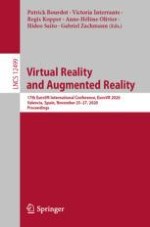2020 | Book
Virtual Reality and Augmented Reality
17th EuroVR International Conference, EuroVR 2020, Valencia, Spain, November 25–27, 2020, Proceedings
Editors: Dr. Patrick Bourdot, Dr. Victoria Interrante, Regis Kopper, Anne-Hélène Olivier, Prof. Hideo Saito, Gabriel Zachmann
Publisher: Springer International Publishing
Book Series : Lecture Notes in Computer Science
